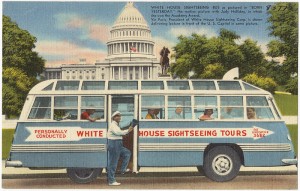By Jack El-Hai (Regular Contributor)
Thousands of people traveled to Washington D.C. in 2013 to attend President Obama’s second inauguration. Who are the people who visit the nation’s capital to see the Chief Executive? For the past 70 years, researchers have wondered about the psychiatric makeup of the President’s visitors — especially those visitors who are psychotic.
From the 1940s
The first study, published in 1943 by Jay L. Hoffman, a psychiatrist at St. Elizabeths Hospital in Washington, examined a group of 53 St. Elizabeths patients, about half of whom had been committed to psychiatric treatment years earlier after showing strange behavior and being turned away at the White House. (The remainder had been hospitalized after their bizarre conduct at other government offices in Washington.) Many had hoped to complain to the President about injustices they believed they experienced in finding employment, being previously confined to mental hospitals, and collecting financial payments they thought they deserved. Some wanted to give advice on matters of national importance. “Two claimed that they had been elected to the office of the President of the United States and came to Washington to be sworn in,” Hoffman wrote.
Hoffman sought patterns and common traits among the psychotic patients and found disproportionate numbers of paranoid schizophrenics, foreign-born people, and unmarried men among them. “Frequent references were made in the records indicating frustration in sex life and poverty of sex-experience,” Hoffman observed. “Delusions and hallucinations referring prominently to sex functions and sex organs were common.”
He wrote that most of these patients notably lacked insight, although they often were pleasant and polite despite their delusions. Few recovered their mental health. Hoffman concluded that members of this group were “a pitiful lot” whose presidential visits were but a single sign of their illness that left them isolated, unsuccessful, and frustrated.
From the 1960s
A 1965 study by Joseph A. Sebastiani and James L. Foy, psychiatrists with the University of Cincinnati and Georgetown University respectively, revisited the phenomenon of psychotic visitors to the White House. They went through the records of 38 patients referred for psychiatric treatment after seeking an audience with the President during the early 1960s. The patients ranged in age from teenagers to an 86-year-old man. Among them were five people in pursuit of property or sums of money, three presumptive presidents, two on “top secret” missions, one self-declared presidential wife, and a woman who claimed to be President Eisenhower’s mother. The psychiatrists characterized the group as “profoundly delusional individuals seeking an exclusive personal encounter with the President and an extraordinary association with the complexly symbolic office of the Presidency.” Nearly all had received diagnoses as paranoid schizophrenics.
The researchers raised the possibility that any similarities among the patients may result from profiles of White House visitors suitable for psychiatric referral that the Secret Service had developed. Sebastiani and Foy concluded that few of the patients had presented actual physical threats to the President.
From the 1980s
Twenty years later, a research team from St. Elizabeths Hospital and the National Institutes of Mental Health took yet another look at psychotic White House visitors. They reviewed the cases of 328 people sent between 1970 and 1974 to St. Elizabeths after problematic attempts to see the President. Like the previous studies, their research showed the patients to be predominantly white, male, unmarried, and paranoid schizophrenic.
Unlike earlier researchers, however, this team found few foreign-born among the patients, and they discovered that 22 percent of the group had made written or verbal threats against the President and other government officials. These psychotic visitors did not view the Chief Executive and his minions as paternalistically as had their counterparts of earlier decades. One of the 328, in fact, went on to murder a Secret Service agent, another attacked a security officer at the Department of the Treasury, and a third assaulted a person she had mistaken for the First Lady.
Sources:
Hoffman, J.L. Psychotic visitors to government offices in the national capital. Am J Psychiatry 99:571-575, 1943
Sebastiani, J.A., Foy, J.L. Psychotic visitors to the White House. Am J Psychiatry 122:679-686, 1965
Shore, David, Filson, C. Richard, Davis, Ted S., Olivos, Guillermo, DeLisi, Lynn, Wyatt, Richard Jed. White house cases: psychiatric patients and the Secret Service. Am J Psychiatry, 142:308-312, 1985
 Jack El-Hai is the author of The Nazi and the Psychiatrist: Hermann Göring, Dr. Douglas M. Kelley, and a Fatal Meeting of Minds at the End of WW2 (PublicAffairs Books) and Non-Stop: A Turbulent History of Northwest Airlines (University of Minnesota Press). He frequently writes articles on history and the history of medicine for such publications as Discover, The Atlantic, Aeon, Scientific American Mind, Longreads, and The Washington Post Magazine (among many others), and he has given presentations for the American Psychological Association, the Congress of Neurological Surgeons, the Mayo Clinic, Yale University, the University of Pennsylvania, Tufts University, and other universities and medical schools.
Jack El-Hai is the author of The Nazi and the Psychiatrist: Hermann Göring, Dr. Douglas M. Kelley, and a Fatal Meeting of Minds at the End of WW2 (PublicAffairs Books) and Non-Stop: A Turbulent History of Northwest Airlines (University of Minnesota Press). He frequently writes articles on history and the history of medicine for such publications as Discover, The Atlantic, Aeon, Scientific American Mind, Longreads, and The Washington Post Magazine (among many others), and he has given presentations for the American Psychological Association, the Congress of Neurological Surgeons, the Mayo Clinic, Yale University, the University of Pennsylvania, Tufts University, and other universities and medical schools.

